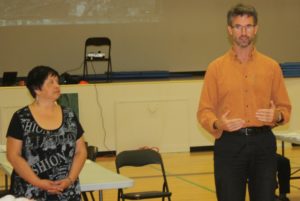Safety Matters: SRFN asks MTO for “humanity in planning” highway changes

By Leslie Knibbs
SERPENT RIVER FIRST NATION—At a recent meeting on October 4, between Serpent River First Nation (SRFN) residents and representatives from the Ministry of Transportation of Ontario (MTO) and their consulting firm AECOM, concerns about the well-being of community members were expressed regarding the safety of Highway 17, which runs through the middle of the community.
Those in attendance included John Fraser and Doug Herbrand, both senior managers with the MTO, as well as engineering consultants Ilya Sher, Raymond Hang, and Hossein Zarei from AECOM, a premier, fully integrated global infrastructure firm with 2016 third-quarter revenue of $4.4 billion. Both the MTO and AECOM are currently involved in a study on Highway 17 and safety issues. Having these senior management individuals attend a meeting asked for by SRFN to address community safety concerns speaks volumes to the thoroughness of the current study on Highway 17 safety matters.
Chief Elaine Johnston told those attending, having a dialogue between SRFN and the MTO as well as AECOM “is an opportunity to discuss [safety] issues and have a voice.” She spoke of two community members lost due to tragedies on the highway this year.
“Over 100 transports on a day in June this year,” Chief Johnston stated, noting that her father had counted the number of transports transiting the highway in a day.”The bottom line is we want to see the speed limit dropped.”
One community member questioned why other small communities have reduced speed limits along highways, yet the highway cutting SRFN in half has a posted speed of 90 kilometres; furthermore, there are passing lanes along several lengths of the road leading to increased speeds which in turn create potential danger for drivers and pedestrians alike.
John Fraser, Manager of Engineering for the Northeastern Region of the MTO said many of the concerns expressed at the meeting were the same as other small communities along the highway. “We cannot engineer good driving behaviour,” he told those attending, but assured everyone their concerns will be studied.
AECOM is a consulting firm employed by the MTO involved in a study of the highway looking to improve safety. At this point in the study, it is in draft form only; more input is expected to be gathered from meetings like the one in SRFN.
Suggestions made to MTO and AECOM included installing flashing amber lights to caution drivers at turn offs. Many community members cautioned the MTO that roads entering SRFN did not have illumination or proper signage making it extremely hazardous for drivers and pedestrians alike. Another suggestion was installation of a mobile radar sign to indicate to drivers the speed they are travelling at. All community members recommended the removal of all passing lanes to discourage speeding.
Perhaps the most recommended change from community members was to make the stretch of highway running down the middle of SRFN a “Community Safety Zone” with proper signage noting that fines for speeding would be doubled within the zone; a good deterrent for speeding. However, when Chief Johnston approached the Ontario Provincial Police about making the area a “Community Safety Zone” last year, she was told, according to one councillor, “they don’t have enough manpower to enforce a Community Safety Zone” in SRFN.
The local Anishinabek Police Services are located in Sagamok Anishnawbek First Nation, half an hour away; moreover, this detachment is understaffed at this time. Another suggestion was to have more solid lines to discourage passing.
The SRFN Elders Lodge, Geka Wigwam, is located directly across the highway from Our Lady of Highway Church. At that point the highway is four lanes across with a passing lane. One Elder pointed out many of the Elders attend church, and move slowly when crossing the highway making for a dangerous situation. Another major concern was no lighting at Village Road East where it crosses the railway tracks.
Not unlike other small communities, people in SRFN walk to their neighbours’, stores and church; however, in this community there is no safe walkway anywhere along the highway. In many cases, the land on the opposite side of the guard rail away from traffic is limited and narrow because of erosion creating a treacherous path. In winter there is no safe walkway whatsoever behind the guardrails.
According to consulting engineer Hossein Zarei from AECOM, consultations are ongoing until the end of 2016; however, following this “back and forth”, discussions will be held until the final study is completed and released. When asked by a community member how long this process would go on for, he said, “for sure not years.”
Aboriginal Liaison Officer Dwayne Pamajewon with the Aboriginal Relations Branch of the MTO will be keeping an eye out assuring all the community’s concerns are addressed allowing for a safer community along the highway in SRFN.


